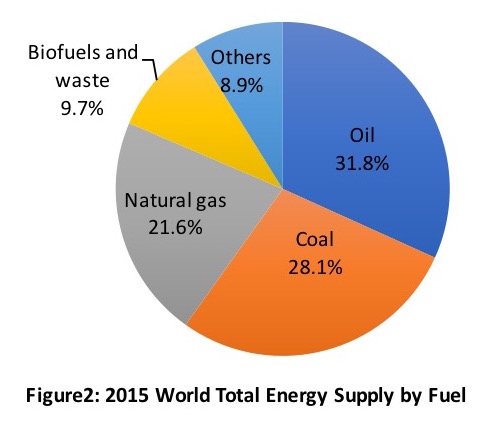1.2.2 Pie Charts
(円グラフ)

Now let me move on to pie charts. Do you know what they are?

Yes. They are like pies, like apple pies, pizzas.

Exactly. A pie chart depicts data in a circle that is divided into multiple segments (or slices). Each segment represents the amount of data in one category. Each category is illustrated as a percentage of the whole data set. For example, one fifth of the pie chart represents 20%.
The pie chart below illustrates the shares of different fuels used to produce energy worldwide in 2015. You can use colors, labels and information keys on the chart to differentiate the categories.
The pie chart below illustrates the shares of different fuels used to produce energy worldwide in 2015. You can use colors, labels and information keys on the chart to differentiate the categories.

(Source: International Energy Agency)
http://www.iea.org/publications/freepublications/publication/KeyWorld2017.pdf
*The PDF is no longer available. [Dec 24, 2020]
http://www.iea.org/publications/freepublications/publication/KeyWorld2017.pdf
*The PDF is no longer available. [Dec 24, 2020]

May, are there any points you should keep in mind when using a pie chart?

I avoid putting too many slices in a pie chart as they could get overcrowded. So, I can place a couple of minor categories in one segment, for instance, and label it, “Others.”

Exactly. Good call, May!

But exactly how many slices are appropriate for each pie?

I would say 3-5.

And can I use any colors I like in a pie chart?

Good question. In fact, there is one particular element you have to keep in mind when choosing colors in pie charts. Some people have difficulty distinguishing between red and green, or blue and yellow.

Do you mean they are colorblind?

Yes. So, if these hard-to-distinguish colors are placed next to each other, some people cannot differentiate the two categories and will see them as one.

Oh. Are there any books I could refer to? I think I should have more details so that my charts will be friendly to everyone’s eyes.

Yes, put phrases, “Color Universal Design” or “Colorblind Barrier Free.” You can find a lot of information on this subject in the search engine.

Thank you. Good to know.